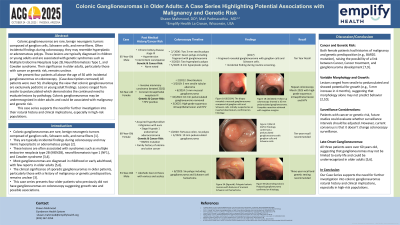Monday Poster Session
Category: Colon
P2523 - Colonic Ganglioneuromas in Older Adults: A Case Series Highlighting Potential Associations With Malignancy and Genetic Risk


Shawn Mahmood, DO
Gundersen Health Systems
La Crosse, WI
Presenting Author(s)
Gundersen Health Systems, La Crosse, WI
Introduction:
Colonic ganglioneuromas are rare, benign neurogenic tumors composed of ganglion cells, Schwann cells, and nerve fibers. Often found incidentally during colonoscopy, they may resemble hyperplastic or adenomatous polyps. These lesions are typically diagnosed in children or young adults and are associated with genetic syndromes such as multiple endocrine neoplasia type 2B (MEN2B), neurofibromatosis type 1, and Cowden syndrome. Their significance in older adults, particularly those with cancer or genetic risk, remains unclear. We present the cases of four patients, all above the age of 50 years, with ganglioneuromas found on colonoscopy.
Case Description/Methods:
Case 1: 65-year-old man with stage 3 chronic kidney disease, hypertension, and intermittent constipation. Colonoscopies: 2006 (two 3-mm sessile polyps), 2017 (tubular adenoma and ganglioneuroma), 2020 (two hyperplastic polyps), and 2025 (8-mm hyperplastic polyp).
Case 2: 64-year-old woman with breast cancer treated in 2022 and prior grade 3 cervical intraepithelial neoplasia. Colonoscopies: 2012 (diverticulosis), 2019 (5 mm tubular adenoma), 2024 (multiple small polyps and a 5-mm sigmoid lesion—biopsy-confirmed ganglioneuroma) with 4-month recall (5-mm pedunculated ganglioneuroma)
Case 3: 60-year-old woman with hypothyroidism, migraines, endometrial cancer, BARD1 gene mutation, family history of uterine and colon cancer, and longstanding bloating and constipation. Colonoscopies: 2020 (tortuous colon, no polyps), 2025 (10-mm pedunculated sigmoid polyp—ganglioneuroma).
Case 4: 53-year-old man with alcoholic cirrhosis and liver failure. No family history of colonic issues. Colonoscopies: Polyps as a child and in teen years with normal follow-ups, 2023 (5 polyps, polypoid ganglioneuroma, polypoid with features of mucosal Schwann cell hamartoma) 3-year recall and genetic testing.
Discussion: All patients were older than 50 years, challenging the view that colonic ganglioneuromas are exclusively pediatric or young adult findings. Lesions ranged from sessile to pedunculated, which demonstrates the continued need to evaluate lesions by pathology. Colonic ganglioneuromas may be underrecognized in older adults and could be associated with malignancy and genetic risk. This case series supports the need for further investigation into their natural history and clinical implications, especially in high-risk populations.
Disclosures:
Shawn Mahmood, DO, Mali Padmavathi, MD, Manny Rehman, MD. P2523 - Colonic Ganglioneuromas in Older Adults: A Case Series Highlighting Potential Associations With Malignancy and Genetic Risk, ACG 2025 Annual Scientific Meeting Abstracts. Phoenix, AZ: American College of Gastroenterology.
